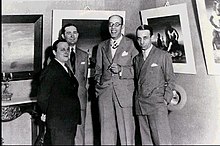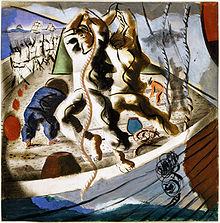Candido Portinari: Difference between revisions
No edit summary |
No edit summary |
||
| Line 23: | Line 23: | ||
[[Image:Discovery of the Land1.jpg|left|thumb|Study for ''Discovery of the Land'' mural at the United States [[Library of Congress]].]] |
[[Image:Discovery of the Land1.jpg|left|thumb|Study for ''Discovery of the Land'' mural at the United States [[Library of Congress]].]] |
||
His career coincided with and included collaboration with [[Oscar Niemeyer]] amongst others. Portinari's works can be found in galleries and settings in Brazil and abroad, ranging from the family chapel in his childhood home in Brodowski to his panels ''Guerra e Paz'' ([[War and Peace (Portinari)|War and Peace]]) in the [[United Nations Art Collection|United Nations]] building in New York and four murals in the Hispanic Reading Room of the [[Library of Congress]] in [[Washington, DC]].<ref>{{cite web|url=http://www.loc.gov/rr/hispanic/portinari.html |title=Portinari Murals at Library of Congress |publisher=Loc.gov |date= |accessdate=2013-03-19}}</ref> The range and sweep of his output is quite remarkable. It includes images of childhood, paintings depicting rural and urban labour, refugees fleeing the hardships of Brazil's rural north-east, treatments of the key events in the history of Brazil since the arrival of the Portuguese in 1500, portraits of members of his family and leading Brazilian intellectuals, illustrations for books, tiles decorating the Church of São Francisco at [[Pampulha]], [[Belo Horizonte]]. There were a number of commemorative events in the centenary of his birth in 2003, including an exhibition of his work in London. [[Image:Flickr - Ministério da Cultura - Guerra e Paz (6).jpg|right|thumb|[["War and |
His career coincided with and included collaboration with [[Oscar Niemeyer]] amongst others. Portinari's works can be found in galleries and settings in Brazil and abroad, ranging from the family chapel in his childhood home in Brodowski to his panels ''Guerra e Paz'' ([[War and Peace (Portinari)|War and Peace]]) in the [[United Nations Art Collection|United Nations]] building in New York and four murals in the Hispanic Reading Room of the [[Library of Congress]] in [[Washington, DC]].<ref>{{cite web|url=http://www.loc.gov/rr/hispanic/portinari.html |title=Portinari Murals at Library of Congress |publisher=Loc.gov |date= |accessdate=2013-03-19}}</ref> The range and sweep of his output is quite remarkable. It includes images of childhood, paintings depicting rural and urban labour, refugees fleeing the hardships of Brazil's rural north-east, treatments of the key events in the history of Brazil since the arrival of the Portuguese in 1500, portraits of members of his family and leading Brazilian intellectuals, illustrations for books, tiles decorating the Church of São Francisco at [[Pampulha]], [[Belo Horizonte]]. There were a number of commemorative events in the centenary of his birth in 2003, including an exhibition of his work in London. [[Image:Flickr - Ministério da Cultura - Guerra e Paz (6).jpg|right|thumb|[["War and Peace"]] was a gift of the Brazilian government to the United Nations and is located at the [[United Nations General Assembly]] building in New York City.]] |
||
On December 20, 2007, his painting ''{{Ill|pt|O Lavrador de Café}}''<ref>http://ritualcafe.files.wordpress.com/2007/07/lavrador-de-cafe.jpg</ref> was stolen from the [[São Paulo Museum of Art]] along with Pablo Picasso's ''[[Portrait of Suzanne Bloch]]''.<ref>{{cite news|author=MacSwan, Angus |title=Security questioned in Picasso theft in Brazil |url=http://uk.news.yahoo.com/rtrs/20071221/ten-uk-brazil-picasso-d3877cb_1.html |date=2007-12-21 |publisher=Reuters}}</ref> The paintings remained missing until January 8, 2008, when they were recovered in [[Ferraz de Vasconcelos]] by the [[Polícia Militar do Estado de São Paulo|Police of São Paulo]]. The paintings were returned, undamaged, to the São Paulo Museum of Art.<ref>{{cite news |author=Winter, Michael |title=Stolen Picasso, Portinari recovered in Brazil|url=http://blogs.usatoday.com/ondeadline/2008/01/stolen-picasso.html|date=2008-01-08 |publisher=[[USA TODAY]]}}</ref> |
On December 20, 2007, his painting ''{{Ill|pt|O Lavrador de Café}}''<ref>http://ritualcafe.files.wordpress.com/2007/07/lavrador-de-cafe.jpg</ref> was stolen from the [[São Paulo Museum of Art]] along with Pablo Picasso's ''[[Portrait of Suzanne Bloch]]''.<ref>{{cite news|author=MacSwan, Angus |title=Security questioned in Picasso theft in Brazil |url=http://uk.news.yahoo.com/rtrs/20071221/ten-uk-brazil-picasso-d3877cb_1.html |date=2007-12-21 |publisher=Reuters}}</ref> The paintings remained missing until January 8, 2008, when they were recovered in [[Ferraz de Vasconcelos]] by the [[Polícia Militar do Estado de São Paulo|Police of São Paulo]]. The paintings were returned, undamaged, to the São Paulo Museum of Art.<ref>{{cite news |author=Winter, Michael |title=Stolen Picasso, Portinari recovered in Brazil|url=http://blogs.usatoday.com/ondeadline/2008/01/stolen-picasso.html|date=2008-01-08 |publisher=[[USA TODAY]]}}</ref> |
||
Revision as of 20:21, 21 December 2014
Cândido Portinari | |
|---|---|
 | |
| Born | Cândido Torquato Portinari December 29, 1903 |
| Died | February 6, 1962 (aged 58) |
| Nationality | Brazilian |
| Known for | painter |
| Notable work | O Mulato, Café, Meninos de Brodowski |
| Movement | Modern Art |
Cândido Portinari (December 29, 1903 – February 6, 1962) was one of the most important Brazilian painters and also a prominent and influential practitioner of the neo-realism style in painting.
Born to Giovan Battista Portinari and Domenica Torquato, Italian immigrants from Veneto, in a coffee plantation near Brodowski, in São Paulo, Portinari studied at the Escola Nacional de Belas Artes (ENBA) in Rio de Janeiro. In 1928 he won a gold medal at the ENBA and a trip to Paris where he stayed until 1930, when he returned to Brazil.
He joined the Brazilian Communist Party and stood for senator in 1947 but had to flee Brazil for Uruguay due to the persecution of Communists during the government of Eurico Gaspar Dutra (1946 to 1951). He returned to Brazil in 1951 but suffered ill health during the last decade of his life and died in Rio de Janeiro in 1962 of lead poisoning from his paints.

His career coincided with and included collaboration with Oscar Niemeyer amongst others. Portinari's works can be found in galleries and settings in Brazil and abroad, ranging from the family chapel in his childhood home in Brodowski to his panels Guerra e Paz (War and Peace) in the United Nations building in New York and four murals in the Hispanic Reading Room of the Library of Congress in Washington, DC.[1] The range and sweep of his output is quite remarkable. It includes images of childhood, paintings depicting rural and urban labour, refugees fleeing the hardships of Brazil's rural north-east, treatments of the key events in the history of Brazil since the arrival of the Portuguese in 1500, portraits of members of his family and leading Brazilian intellectuals, illustrations for books, tiles decorating the Church of São Francisco at Pampulha, Belo Horizonte. There were a number of commemorative events in the centenary of his birth in 2003, including an exhibition of his work in London.
On December 20, 2007, his painting pt[2] was stolen from the São Paulo Museum of Art along with Pablo Picasso's Portrait of Suzanne Bloch.[3] The paintings remained missing until January 8, 2008, when they were recovered in Ferraz de Vasconcelos by the Police of São Paulo. The paintings were returned, undamaged, to the São Paulo Museum of Art.[4]
References
- ^ "Portinari Murals at Library of Congress". Loc.gov. Retrieved 2013-03-19.
- ^ http://ritualcafe.files.wordpress.com/2007/07/lavrador-de-cafe.jpg
- ^ MacSwan, Angus (2007-12-21). "Security questioned in Picasso theft in Brazil". Reuters.
- ^ Winter, Michael (2008-01-08). "Stolen Picasso, Portinari recovered in Brazil". USA TODAY.
